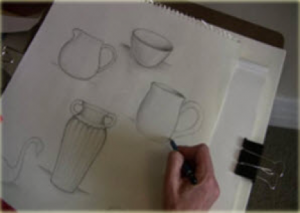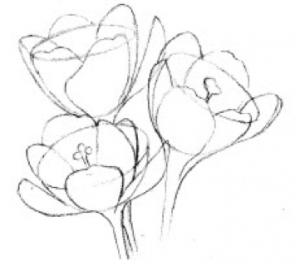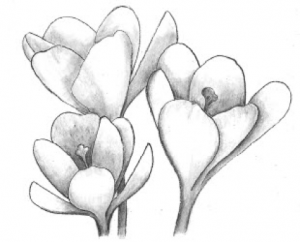Six BEST Tips for Starting to Draw
- FIRST OF ALL . . . Don’t start worrying before you’ve even tried! If you want to draw all you need to get started is your eyes, a hand steady enough to print your name legibly, a pencil, eraser and paper! Whether you think you have talent or feel certain that you don’t doesn’t matter at all! Drawing is not about talent! Now if by chance you are one of those people who think you can’t even draw stick people or draw a straight line with a ruler know that I am laughing right out loud! I know you . . . I’ve talked to you and you’ve probably told me that more than once and I’ll tell you again . . . that is nonsense! Learning to draw is absolutely not about talent, it is about developing an ability! The only acceptable excuse is that when it comes right down to it – you simply don’t want to do it. And that is certainly your choice, but for those who are interested read on!
- Pick simple subjects – make a list of 10 easy things that do not have a lot of detail. Don’t start with faces or anything complicated because in so doing you are more likely to get discouraged before you really get started. Look around your house or your yard and find the things on your list so you are drawing a specific item. Making the list before you start will help to keep you drawing . . . you won’t get stalled trying to figure out what to draw next.

- Start small – Cut up 10 pieces of 8 ½” x 11” paper into fourths so you have a stack of 4 small pieces from each sheet. Regardless of the subject, smaller sized drawings don’t take nearly as long to complete as it would on a full size sheet of paper. If you don’t have to spend forever trying to get a drawing right you are also more likely to keep at it. Make a commitment that you won’t give up trying until you have filled each paper. At one drawing a day that’s enough to last almost 6 weeks . . . and that leads us to tip number four!
- Draw often . . . . Learning to draw well or to do anything well is mostly a matter of commitment and then investing some consistent time to work at it. We all know someone who brags about how long they’ve been drawing or painting, however, the important measurement is not in how long they’ve been doing it but in how much time they invest doing it! Twenty years sounds like a long time but someone who has been drawing for 20 years isn’t necessarily someone who can draw well. If we only sit down to it for a day or two every 4 or 5 months or if we only pick up a pencil once a week for a class it’s going to take a long time to make any notable progress . When I was in college I had an art teacher who every Monday had us turn in a packet of daily drawings for the previous week. At first it was hard deciding what to draw since it could be anything and that was a little stressful just trying to come up with something. But after a few weeks into it I relaxed and realized it really didn’t matter what I drew – what mattered is that I did it. Practice makes perfect (eventually)! But without consistent practice we won’t make the desired progress and every time we decide to give it a try it will be more like starting over. Most people who give up drawing get discouraged without ever making the commitment or really putting in the time. How badly to you want something? Where there’s a will there’s a way and for learning to draw the way is to spend consistent time working at it! Make a commitment to draw something on one of those little 4”x5” papers every single day!
- Ready to start? Make comparisons as you go – the more the better! If I had to pick a #1 most important thing this would be it! You draw what you see so it should make perfect sense that drawing well is tied to being able to observe well. Even with the most simple of subjects, the proportions, angles, and curves need be correct for your item to be drawn accurately. How does one thing or part relate to another? Is it taller, wider, steeper, more curved, less curved, straighter, thicker, or more pointed, is there more space between parts or less, etc. Once you’ve done your best put your drawing away so you can look at today’s drawing tomorrow with fresh eyes. If it doesn’t “look right” check and compare again and make adjustments. Ask yourself what is the same and what is different and be specific! If you do all that and you know something is still wrong ask for someone else’s opinion. But don’t just ask what they think! Show them the item you were drawing and also your actual drawing. Ask them what looks different about your drawing than the actual item . . . they just may be able to point out a difference you overlooked. You know the saying of not being able to see the forest for the trees? Critiquing your own work can be a lot like that . . . often the things that need to be adjusted are rather simple . . . that you have a certain proportion off or that some part needs to curve more! Again the most important drawing key is making accurate comparisons!
- I would be amiss if I didn’t say that drawing lessons will help . . . a good teacher will help you learn to “see” better and teach techniques that make things easier. It’s kind of like learning to ride a bike – you can observe others doing it and decide you are going to give it a try. The more closely you observe all the little details of how to push off and petal, how much speed is needed to be able balance, how to steer, how to slow down, when to put your foot down when you are stopping, the greater your chance of being successful when you try it. But, it is easier if someone who knows all those things is there to help and remind you, to point out what you are doing right and what you need to do differently, to straighten you when you lean too much, to catch you when you tip over, and to help you practice until you are successful and comfortable with it on your own! Yep, it’s just like learning to draw!
This is a direct link to sign up for my drawing class: http://store.artapprenticeonline.com/drawing/. I’d love to have you participate with us!




Leave a Reply